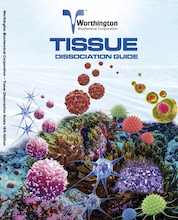For our international customers, please be advised that orders cannot be placed through our website by customers in countries with International Distributor representation.
Worthington Tissue Dissociation Guide
Methods and Materials: Cell Adhesion and Harvesting
During interphase, fibroblast-like cells in culture are spread out on the substratum in a characteristic, spindle-shaped configuration. There are differences of opinion as to whether the actual areas of cell adhesion are distributed over most of the undersurface of the cell or are localized in relatively narrow patches near the cell margins, principally in the vicinity of ruffling activity. In either case, these areas of adhesion appear to be composed of clusters of attachment points, each about 1 µm in diameter. The individual attachment points are apparently the distal portions of a cell cytoskeleton structure bound to the substratum.
Within minutes after subjecting cultured cells to cold temperatures, chelating agents or trypsin solutions, they change shape drastically by rounding up and blebbing. Electron micrographs show many long retraction fibers with a diameter of 0.25 - 0.5 µm running from the surface of the rounded cell body to enlarged, terminal bulb attachment points previously located on the flattened cell's undersurface.
The cells remain attached to the substratum until the fibers are broken, either mechanically by tapping or shaking the culture vessel, or chemically by the continued action of chelators and/or trypsin. (Cold temperatures alone are sufficient for rounding up but not for detachment. These conditions also greatly diminish the entry of trypsin into the cell.) Soon after cell detachment from the surface of the culture vessel, and subculture into new vessels containing trypsin-free medium, cytoplasm flows into the broken retraction fibers and refills them. Within an hour the rounded cells begin to take on their characteristic shape.
Tissue Tables
The Worthington Tissue Tables provide references useful to researchers interested in tissue dissociation and cell harvesting procedures. The references are organized by Tissue and Species type and linked to PubMed citations. The Cell type, Enzymes, and Medium for each reference is provided.
To search by specific criteria, use the Tissue References Search Tool.
